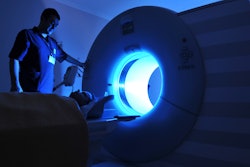
CT angiography-derived fractional flow reserve (CT-FFR) imaging helps clinicians assess stable angina patients' adverse outcome risk -- even if they have high coronary artery calcium scores, research published September 12 in Radiology has found.
Why? Because CT-FFR incorporates coronary CT angiography (CCTA) images of the heart, AI algorithms, and computational fluid dynamics to estimate the amount of blood flowing through the coronary arteries, the RSNA said in a statement about the study.
"CT angiography is the first step in identifying the presence of coronary artery disease, but it doesn't show the impact on blood flow in the arteries," lead researcher Kristian Madsen, MD, of the University Hospital of Southern Denmark in Esbjerg said in the RSNA statement. "Turbulent blood flow may create abnormal pressure in the vessel that grinds down coronary plaques making them prone to rupture."
Patients being evaluated for coronary artery calcium typically undergo noncontrast cardiac CT before coronary CT angiography; the amount of coronary artery calcium (CAC) identified helps estimate a patient's coronary plaque, high levels of which (400 or higher) can lead to heart attack. But it can be difficult to assess coronary CT images of patients with high CAC scores because calcium absorbs x-rays, the researchers explained.
That's where CT-FFR comes in. The technique shows high diagnostic performance, and its results correlate well with invasively measured fractional flow reserve, according to Madsen.
"In my opinion, CT-FFR is the best option because it provides a blood-flow estimate similar to what you would obtain if you performed invasive heart catheterization," he said. "You get a reliable and quick answer without performing additional tests or putting the patient through an invasive procedure."
Madsen and colleagues performed a study that included 900 patients with newly diagnosed, stable coronary artery disease who were enrolled in a trial conducted at three Danish sites between December 2015 and October 2017 called Assessing Diagnostic Value of Non-Invasive CT-FFR in Coronary Care (ADVANCE). Study participants were eligible if they had at least one coronary artery stenosis greater than 30% and no irregular heartbeat or prior coronary revascularization.
Of the 900 participants, 523 had normal and 377 had abnormal CT-FFR results. The team found the following regarding three-year adverse outcomes (that is, all-cause deaths and/or nonfatal heart attacks):
| 3-year adverse outcome rates for normal and abnormal CT-FFR result patient cohorts | ||
| Measure | Normal CT-FFR results | Abnormal CT-FFR results |
| Rate of three-year adverse outcomes | 2.1% | 6.6% |
| Rate of three-year adverse outcomes by high CAC score | 2.2% | 9% |
The study findings will help clinicians categorize patient risk level for coronary artery disease and perhaps even improve the prognosis of high-risk patients.
"Our study provides evidence for the prognostic potential of CT-FFR in patients with high coronary artery calcium scores," Madsen said. "Regardless of the patient's baseline risk and extent of coronary artery disease measured by coronary artery calcium, if CT-FFR results are normal, the prognosis is good."
The complete study can be found here.





















